Layouts
History of the Folsom Eastern Railroad
Mar 16, 2005


By Dennis Winger |
Author
Bio
Following several years of planning, the Folsom Eastern Railroad Company finally began construction.
|
| Editors Note: This is part one of a multi-part series that chronicles the building of a garden railroad. It is a compilation of smaller articles originally written by Dennis Winger for The Valley Flyer, club newsletter for the Sacramento Valley Garden Railway Society in the greater Sacramento, California area. Dennis is 57 and has worked around or on railroads most of his adult life. His wife, Susan Patterson, and their four cats occasionally allow him indoors at their home in Folsom, California. The other names used in the articles are friends or fictional characters...or both. |
July, 2001 Following several years of planning, the Folsom Eastern Railroad Company finally began construction. With the recent completion of its general shops and approval of its chief financial officer for the purchase of retaining wall materials, the FE Line plans to start limited operation by next Spring. The narrow gauge railroad will link the small mining town of Spenser, the Scandanavian settlement of Oskiwawa, and the growing community of Magnolia. 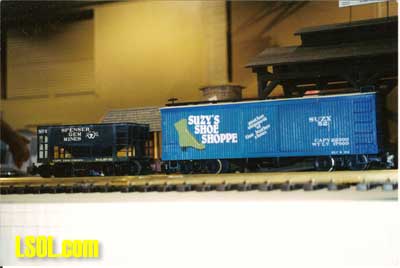 Two customers on the Folsom Eastern Railroad (The FE Line) took delivery of their first cars shortly after railroad planning began. The Spenser Gem Mines car lists its capacity in carats, not pounds. |
Construction of company housing in Spenser will begin soon. Spenser Gem Mine officials are looking forward to construction of the mountain and delivery of the ore for their company to mine. The company has already purchased a used hopper for shipment of its ore. Oskiwawanites also welcome the coming railroad. Long-time fantasy cattle ranchers, many of the residents look forward to finally getting real homes and real plastic cattle.
Magnolia is the largest and most modern of mountain communities in the immediate area. Under construction are the town's gasoline station and garage, a bakery, and a small warehouse. Construction is urgently needed for Suzie's Shoe Shoppe, which will have its own spur and loading dock. The railroad's Chief Financial Officer and Director of Development, Susan Patterson, is the owner of the upscale store and has already taken delivery of her first boxcar. The Acting General Manager, Dennis Winger, has purchased a variety of rolling stock and continues to look for appropriate additional equipment. Initial motive power will be a 4-6-0 built for the Denver and Rio Grande Western by Bachmann Locomotive Works and an 0-4-0 tank engine, also built by BLW. Both were purchased new from the factory after the intended owners declined to make further steam locomotive purchases. Further motive power purchases will depend upon available financing and "need." The site of the railroad, complete with owner's quarters, was originally discovered and surveyed by the Chief Financial Officer, Director of Development and Secretary of Social Activities (Susan Patterson) while the acting general manager was out of town. Upon his return and following the purchase of the property, he was instructed by Patterson to begin railroad planning immediately. Patterson appears assured of a long tenure in her current position. 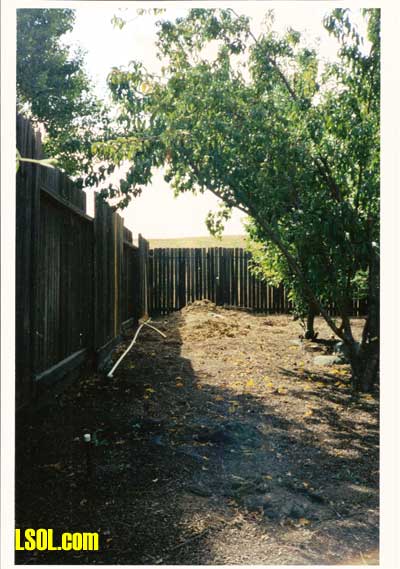 Future site of the FE Line as surveyed by Executive Director Susan Patterson. Based on the author's renowned gardening skills, Patterson determined the trees in the photo to be a rare species (treeum alivus) and declared them as protected. |
Construction of the general shops was subcontracted to Leonard Cassieri Construction Company and was completed within two weekends. The shop building measures four feet by sixteen feet and is complete with a full-width end door, a side door and a window overlooking the (future) empire. Construction Still on Schedule October, 2001 Construction of the retaining wall which will contain the Folsom Eastern Railroad continues at a feverish pitch. Acting General Manager Dennis Winger is abiding by the LCCM (Leonard Cassieri Construction Method) and intends to have the foundation for the 40 foot by 12 foot wall completed soon. To date, Director of Development Susan Patterson appears amenable to the "soon" timetable for construction. Limited operation is still planned for next spring. Spenser Gem Mines recently acquired a major structure necessary for its mine. Stenworks Engineering was the low bidder for construction of the headframe and adjoining ore house. Director of Development and Head of Acquisitions Susan Patterson was present at the unveiling of the imposing structure and pronounced it "cute" (Note to general offices: henceforth, nothing associated with the FE Line will be publicly referred to as "cute."). 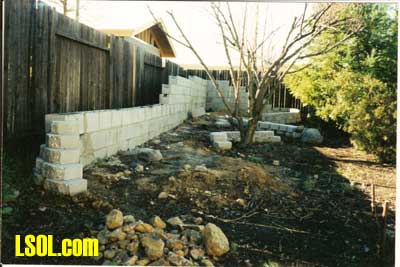 In answer to Executive Director Patterson's question: "Yes-this is as far as I got in nine months." |
For those unfamiliar with the history behind the Folsom Eastern Railroad, perhaps some background is in order. The name, actually suggested by Dick Friedman, allows the indirect reference to the home city of the owners' headquarters and their cats. Nearly all the locations and businesses are named for cats residing with the owners now or in the past. Operation of the FE Line is intended as a reflection of the owner's whimsical approach to their interests. This would preclude rivet-counting. In the beginning, the railroad will consist of a single-track mainline loop with a maximum grade of about 2 percent, with one siding at Oskiwawa for the cattle chute and two spurs - one to Spenser Gem Mines and one to serve the burgeoning commercial development at Magnolia. Acting General Manager Dennis Winger is bravely facing the prospect of bending rail, as sectional track is not considered suitable for the curves intended in the mountainous region. In addition, track power will be used initially until Director of Development, Head of Acquisitions, and Chief Financial Officer Susan Patterson approves funding for RC operation. 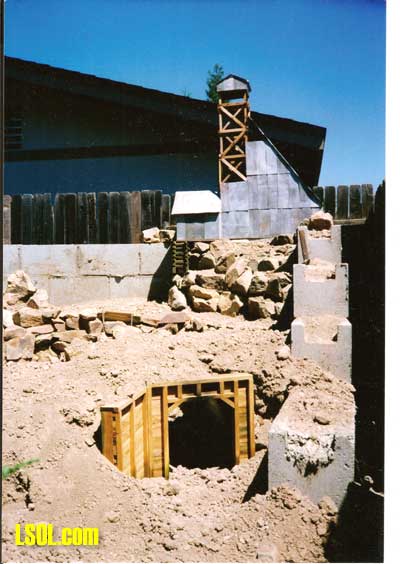 The largest structure at Spenser Gem Mines (and the railroad) towers over the future town site of Magnolia. The loop tunnel was wisely set in place prior to delivery of the mountain. |
In order to assure continued financing for track purchases and other buildings (a sudden need for a hoist house, power house and stamp mill has arisen at Spenser Gem Mines), the acting general manager is cognizant of the need to observe Rule H on occasion. According to the FE Line General Code of Operating Rules, Rule H is defined as the "Honey-do Rule." No further explanation is necessary. Weather Woes Slow Construction January, 2002 After an initial flurry of activity, construction on the Folsom Eastern Railroad (the FE Line) has all but ceased due to the seemingly endless parade of storms and holidays. After several weeks of eyeing the stacks of cement blocks, decorative stone and idle tools in an empty side yard, Chief Financial Officer and Landscape Planning Director Susan Patterson has begun to express doubts about the railroad's projected completion date of Spring, 2002. Rather than discussing with Patterson her definition of "completion," Acting General Manager Dennis Winger has seen the wisdom of embarking on an ambitious public relations campaign involving Christmas, jewelry and an extended credit limit on his VISA card. Perhaps fellow SVGRS member Dick Friedman was correct when he described our railroads as not so much "layouts" as "outlays." On a much more serious note, the weather and holidays haven't been the only setback to the construction schedule of FE Line. About a year ago my father, Bill Winger, Sr., was diagnosed with inoperable liver cancer. His home was in Grants Pass, Oregon, and I had been driving up there about every three weeks this last year to take him to Medford for doctor's visits and to spend some time with him. In the last few years, he had joined Southern Oregon Large Scale Trains (SOLST) - a great garden railroad club - and planned to build his own pike in his spacious and barren back yard. He acquired locomotives and rolling stock, and together he and I built a couple of modules for his club. Joe and Irene Zajac and all the others in the group were a great bunch of people - they welcomed Dad into the group and put up with his poor puns and repeated stories.
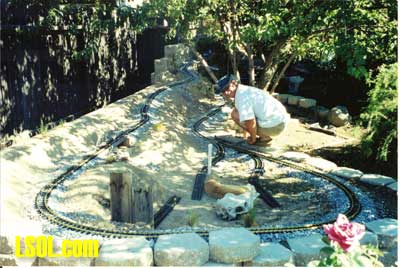 The author and Official Railroad Cat Mick Magoon share a tender moment near the future site of Oskiwawa. Due either to forced perspective or Friskies, Mick appears to be as large as a house. |
My dad always liked trains and as a youngster I learned to love trains through him. For the last few years we were a young dad and his younger son "playing" together with trains once again. Dad died November 8th at age 83. Dad's collection is with me now, including the Bachmann woodside reefer kit I'd assembled and lettered for the Oskiwawa Railroad Company for him on his 81st birthday. Oskiwawa was one of his nonsensical terms he'd use to hurry all us kids along when we were much younger. It's now a town on my railroad - a railroad that is as much my dad's as it is mine. The next installment will chronicle the building of a garden railroad. Really. Top of Page
|



